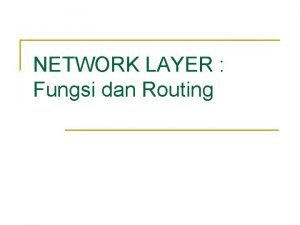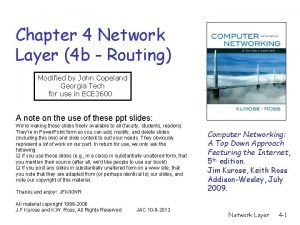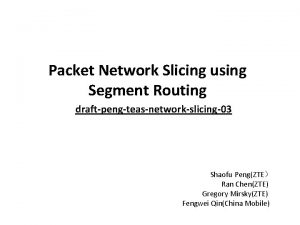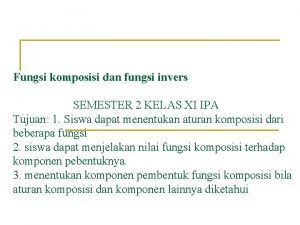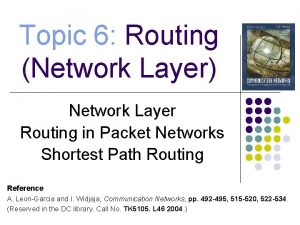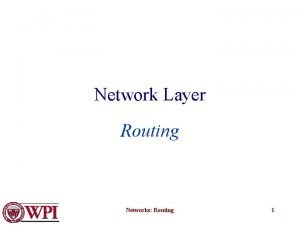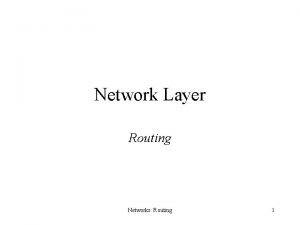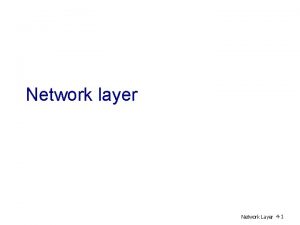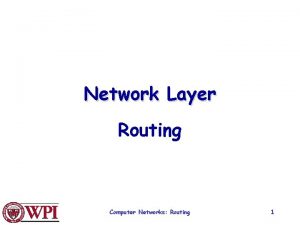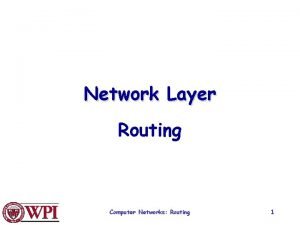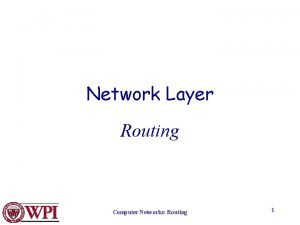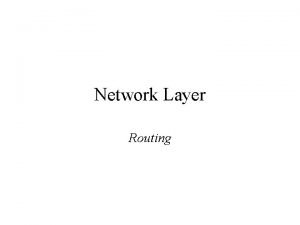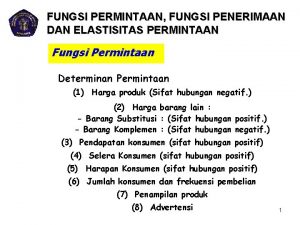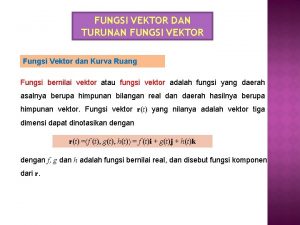NETWORK LAYER Fungsi dan Routing Fungsi network layer










![Load balancing R 192. 168. 6. 0/24 [120/1] via 192. 168. 2. 1, 00: Load balancing R 192. 168. 6. 0/24 [120/1] via 192. 168. 2. 1, 00:](https://slidetodoc.com/presentation_image/6283d3a318b9bca2152b1712266e885e/image-11.jpg)















![Administrative distance D 192. 168. 6. 0/24 [90/2172416] via 192. 168. 2. 1, 00: Administrative distance D 192. 168. 6. 0/24 [90/2172416] via 192. 168. 2. 1, 00:](https://slidetodoc.com/presentation_image/6283d3a318b9bca2152b1712266e885e/image-27.jpg)


- Slides: 29

NETWORK LAYER : Fungsi dan Routing

Fungsi network layer n n Membawa paket dari host pengirim ke penerima Protokol network layer ada di setiap host dan router Tiga fungsi utama: n path determination: menentukan rute yang ditempuh paket dari sumber ke tujuan (Routing algorithms) n switching: memindahkan paket dari input router ke output router n call setup: beberapa arsitektur jaringan mensyaratkan router call setup sepanjang jalur sebelum data dialirkan application transport network data link physical network data link physical network data link physical application transport network data link physical

Protokol yang diimplementasikan pada Lapis 3: n n Internet Protocol version 4 (IPv 4) Internet Protocol version 6 (IPv 6) Novell Net. Ware Internetwork Packet Exchange (IPX) Apple. Talk

Routing protocol 5 Goal: menentukan suatu jalur yang “baik” (router-router yang berurutan) melalui suatu jaringan dari source kedestination. Graph abstraction untuk algoritma routing : n graph nodes (vertex) adalah routers n graph edges (arc) adalah link fisik n link cost 2 A 2 1 n B D 3 C 3 1 5 F 1 E 2 Jalur yang “baik” : q Biasanya berarti jalur dengan biaya yang minimum q Bisa jadi ada definisi lain

Static or dynamic? Static: Pergantian rute berlangsung lambat (dilakukan administrator) Dynamic: Rute berganti lebih cepat n q q Update secara periodik Respon bila cost link berubah

Inter & Intra domain n n Inter Domain : BGP (antar AS) Intra Domain : OSPF, RIP, IGRP (didalam AS)

Autonomous systems n Autonomous systems divide up the global internetwork into manageable units

Interior and Exterior RIP in AS 62 24 -Sep-20 BGP used between EIGRP in AS 36 BGP used between S Ward Abingdon and Witney College OSPF in AS 98

Routing Algorithm classification Global or decentralized information? Global: n Semua routers mempunyai informasi yang lengkap mengenai topologi dan biaya link. n “link state” algorithms (OSPF dan IS-IS) Decentralized: n router hanya mengetahui perangkat yang terhubung kepadanya secara fisik serta biayanya. n Proses komputasi yang iteratif dan pertukaran informasi dengan tetangganya. n “distance vector” algorithms (RIP, IGRP and EIGRP)

n Metric (cost) yang bisa digunakan : q q q Hop count Bandwidth Delay Load Reliability BER Maximum transmission unit
![Load balancing R 192 168 6 024 1201 via 192 168 2 1 00 Load balancing R 192. 168. 6. 0/24 [120/1] via 192. 168. 2. 1, 00:](https://slidetodoc.com/presentation_image/6283d3a318b9bca2152b1712266e885e/image-11.jpg)
Load balancing R 192. 168. 6. 0/24 [120/1] via 192. 168. 2. 1, 00: 24, Serial 0/0/0 [120/1] via 192. 168. 4. 1, 00: 26, Serial 0/0/1 n n n Routing table lists two routes to the same destination, with the same metric. Both routes were discovered by the same protocol. Both routes will be used.

Distance Vector n n Algoritma beroperasi dengan memaintain tabel routing dari setiap router. Tabel routing diupdate secara periodik. Pada lingkungan pure distance vector, update routing secara periodic melibatkan pengiriman routing table tetangga secara full.


Problem

PROBLEM n count-to-infinity Jika misal ruter A down. B tidak “mendengar” apapun dari A. Namun C “mengatakan” bahwa mengirim paket ke A bisa lewat C. dst. . . q n n Solusi tetapkan nilai maximum Routing loop solusi : split horizon (tidak mengirimkan informasi kembali ke pengirim) Update message yang tidak perlu solusi : holddown timer

Link State n Pada link state, router melakukan: q q q n n n Mempelajari network address dari tetangga Menghitung delay atau cost setiap tetangga Membentuk paket utk menyebarkan informasi ruting yang baru dipelajari Mengirim paket pada tiap router Menghitung shortest path ke tiap router. Paket link state (link state advertisement – LSA) identitas sender, sequence number, age Link state mengumpulkan informasi dari seluruh router dalam jaringan atau dalam area tertentu dan kemudian setiap router menghitung path terbaiknya secara independen. Jika terjadi failure, dikirimkan LSA. Masing-masing router akan mengcopy LSA, mengupdate databasenya, dan memforward database tersebut ke tetangganya. LSA menyebabkan rouer melakukan perhitungan kembali best path nya.


n Contoh link-state network hierarchi: q q n n Area : grouping of contiguous network AS : sejumlah network dalam administrasi yang sama yang men-share strategi routing yang sama. Misal di OSPF : area bacbone, area border router, nonbackbone internal router, Misal di IS-IS : router L 2, L 1/L 2, L 1

Link State Algorithm n DX(Y, Z) = jarak dari X ke Y, melalui Z sebagai hop selanjutnya = c(X, Z) + minw. Z{D (Y, w)}


Routing protocols Interior gateway protocols Classful Classless IPv 6 24 -Sep-20 S Ward Abingdon and Witney College Exterior gateway protocols

Routing protocols Interior gateway protocols Classful Classless IPv 6 Distance vector, open standard 24 -Sep-20 S Ward Abingdon and Witney College Exterior gateway protocols

Routing protocols Interior gateway protocols Classful Classless IPv 6 Distance vector, Cisco proprietary 24 -Sep-20 S Ward Abingdon and Witney College Exterior gateway protocols

Routing protocols Interior gateway protocols Exterior gateway protocols Classful Classless IPv 6 Link state 24 -Sep-20 S Ward Abingdon and Witney College

Administrative distance n n n Different routes could be found by different routing protocols, or one route could be dynamic and one static. The route with the lowest administrative distance is used. Administrative distance is an indication of the “trustworthiness” or desirability of a route. 24 -Sep-20 S Ward Abingdon and Witney College

Administrative distances n n n n 0 directly connected 1 static route 90 route found using EIGRP 100 route found using IGRP 110 route found using OSPF 120 route found using RIP Maximum possible value is 255 These are default values. 24 -Sep-20 S Ward Abingdon and Witney College
![Administrative distance D 192 168 6 024 902172416 via 192 168 2 1 00 Administrative distance D 192. 168. 6. 0/24 [90/2172416] via 192. 168. 2. 1, 00:](https://slidetodoc.com/presentation_image/6283d3a318b9bca2152b1712266e885e/image-27.jpg)
Administrative distance D 192. 168. 6. 0/24 [90/2172416] via 192. 168. 2. 1, 00: 24, Serial 0/0 R 192. 168. 8. 0/24 [120/1] via 192. 168. 3. 1, 00: 20, Serial 0/1 n n n Two routing protocols running on a router linking two areas with the different protocols Administrative distances are the defaults for the routing protocols. D means EIGRP. Note the metric is not hop count. 24 -Sep-20 S Ward Abingdon and Witney College

SEKIAN

Algoritma Distance Vector Pada semua node, X: 1. Inisialisasi 2. Untuk semua node bersebelahan v 3. DX(*, v) = ∞ {* berarti untuk semua baris} 4. DX(v, v) = c(X, v) 5. Untuk semua tujuan, y 6. Kirim minw. XD (y, w) kesetiap tetangga 7. loop 8. tunggu (sampai ada perubahan cost link ke tetangga V atau diterima update dari tetangga V) 9. If (c(X, V) berubah dengan d) 10. then untuk semua tujuan y: DX(y, V) = DX(y, V) + d 11. Else if (diterima update dari V dengan tujuan Y) 12. then untuk tujuan tunggal y: DX(Y, V) = c(X, V) + nilai baru 13. IF ada nilai baru minw. DX(Y, w) untuk semua tujuan Y 14. then kirim nilai baru minw. DX(Y, w) ke semua tetangga 15. terus menerus
 Fungsi utama network layer
Fungsi utama network layer Muskingum method
Muskingum method Mark tinka
Mark tinka Hydrologic continuity equation
Hydrologic continuity equation Clock skew
Clock skew Contoh soal fungsi non linear
Contoh soal fungsi non linear Inter vlan routing layer 3 switch
Inter vlan routing layer 3 switch Arg
Arg Layer 4 routing
Layer 4 routing Fungsi network layer
Fungsi network layer Fungsi utama layer network
Fungsi utama layer network Network slicing with segment routing
Network slicing with segment routing Turunan fungsi komposisi
Turunan fungsi komposisi Contoh soal perhitungan routing sheet
Contoh soal perhitungan routing sheet Pigmented layer and neural layer
Pigmented layer and neural layer Git layers
Git layers Secure socket layer and transport layer security
Secure socket layer and transport layer security Layer 6 presentation layer
Layer 6 presentation layer Secure socket layer and transport layer security
Secure socket layer and transport layer security Secure socket layer and transport layer security
Secure socket layer and transport layer security Secure socket layer and transport layer security
Secure socket layer and transport layer security Layer 2 e layer 3
Layer 2 e layer 3 Layer-by-layer assembly
Layer-by-layer assembly Layer 2 vs layer 3 bitstream
Layer 2 vs layer 3 bitstream Gambar grafik fungsi biaya
Gambar grafik fungsi biaya Fungsi permintaan dan penawaran
Fungsi permintaan dan penawaran Titik pulang pokok rumus
Titik pulang pokok rumus Aturan fungsi invers
Aturan fungsi invers Fungsi komposisi dan fungsi invers
Fungsi komposisi dan fungsi invers Layer data link adalah
Layer data link adalah
